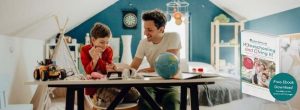Is your first year as a homeschooling family? Or have been homeschooling for years? Either way, preparing your child’s learning space for academic success is important. In fact, many homeschooling parents believe it is important to consider a child’s learning style when creating their learning space. A child’s learning style is their natural way of processing information in different learning situations. As a parent, when you better understand your child’s learning style, you can become better partners in the process.
What is Your Child’s Learning Personality?
Naturally, one important aspect of a child’s learning style is their learning personality. A child’s learning personality is how they naturally express interest in learning. It is important to consider their learning personalities as well as the learning environment they prefer. The following factors can contribute to a child’s learning environment:
 Physical location – at home or in a classroom
Physical location – at home or in a classroom- Physical position – sitting, walking around, laying down
- Sound or lack of sound – quiet, ambient noise, or music
- Color of the room
- Awareness of self
- Time of day or night
Does your child need a completely quiet place to study for an exam? Do they concentrate better while listening to music? Are their best papers written while they sit at a desk completely clear of clutter? Or while they are lying on their bed surrounded by pillows, books, papers, and the family pet?
Fix Your Homeschool Space to Maximize Learning
Dr. Patricia Tanner Nelson from the University of Delaware said, “Make your home a place where it is easy to learn.” In fact, when students take the time to create their learning space with consideration for personal preferences and learning style, academic outcomes improve. Make the most of your school year by setting up your student’s ideal workspace.
Consider the following ideas.
If your child’s learning style is:
- Relating/inspiring, he or she probably enjoys cooperative learning and group discussions. Think about ways to get your student involved with other children. In addition, many students receive the benefit of joining a wide range of online clubs for grades K-8 and 9-12, and interacting with other students virtually.
- Thinking/creating, he or she probably is a creative person who likes time to dream, think, and wonder. Consider making a quiet, comfortable retreat for your student, where he or she can imagine the possibilities related to what they are learning in school.
- Inventing, he or she probably likes projects, design, and research. Their ideal learning space might include supplies for making prototypes, access to reference materials for research, and space to spread out and working while bringing new ideas to life.
- Performing, he or she probably likes to entertain people, participate in a variety of shorter activities, and experiment with many kinds of quick learning exercises. Your child might learn best in an environment that provides the opportunity to showcase talents, allows breaks for physical exercise, integrates games and enhances learning with posters, maps, and audiobooks.
- Producing, he or she probably enjoys a sense of order and thinks in a logical, sequential manner. Your child would enjoy a learning space that is carefully organized, with shelves, bins, and folders for all of their books, papers, and other school supplies. Consider a wall calendar or planning to keep track of due dates, and think about using a daily “to do” list that can keep your child on target by checking off completed work.
Need some additional inspiration? Check out what these students have done with their learning spaces. This Pinterest board, “Set Up Your Learning Space” contains more than one hundred snapshots to provide you with ideas on how to set up your child’s learning space in a way that will best match their learning style.




